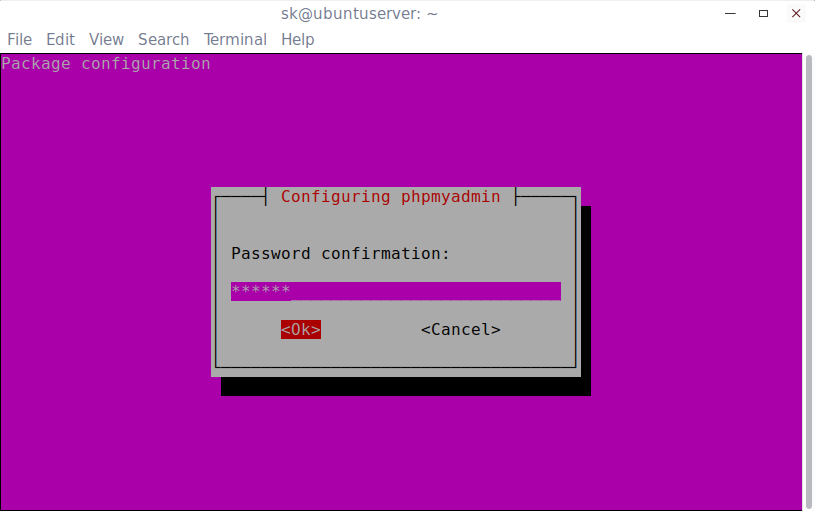In this test I learn how to install phpMyAdmin. PhpMyAdmin is a web-based tool that allows users to easily manage MySQL or MariaDB databases. If you’re not comfortable I have been playing with Ubuntu 18.04 LTS, soon to be released. Minimal Ubuntu 18.04 server Installation. We will explain how to install LAMP stack with PhpMyAdmin in Ubuntu 18.04. Step 1: Install Apache Web Server on Ubuntu.

A LEMP stack is made up of Nginx (pronounced Engine X), MySQL/MariaDB and PHP/Python packages installed on a Linux system, and configured to work together as a system for hosting websites and applications and more. In this guide, we will show how to install LEMP and the latest phpMyAdmin in Ubuntu 18.04. Read Also: PhpMyAdmin is a free, open source, popular and intuitive web-based application for administering MySQL and MariaDB database, which supports a wide range of operations. It has a multitude of features for simply managing your databases from a web interface.
It allows you to import and export data in various formats, manage multiple servers, build complex queries using Query-by-example ( QBE), create graphics of your database layout in various formats, and so much more. Requirements: • Minimal Ubuntu 18.04 server Installation. • Access to server via a SSH session. • Root access or use to run all commands. In this article, we will explain how to install LEMP stack with PhpMyAdmin in Ubuntu 18.04.
Step 1: Install Nginx Web Server on Ubuntu 18.04 1. First start by updating your software packages and then install Nginx, an open source, fast and high-performance web server, load balancer as well as reverse proxy with an easy to understand configuration language. $ sudo apt update $ sudo apt install nginx 2. Once you have installed it, the Nginx service should start automatically and will be enabled to start at boot time, you can check if it’s up and running. $ sudo systemctl status nginx 3. If you have a firewall enabled and running on your system, you should open the ports 80 ( HTTP) and 443 ( HTTPS) to allow client requests to Nginx web server, and reload the firewall rules. $ sudo ufw allow 80/tcp $ sudo ufw allow 443/tcp $ sudo ufw reload 4.
Next, test if the Nginx package was successfully installed and is working fine, type this URL in your web browser. OR If you see the Nginx default web page, it means your installation is working fine. Check Nginx Web Page Step 2: Install MariaDB on Ubuntu 18.04 5. Next install MariaDB database management system. $ sudo apt install mariadb-server mariadb-client 6.
After MariaDB installation, the service should start automatically and you can verify it using following command. $ sudo systemctl status mysql 7. Next, secure your MariaDB installation by running the security script that comes with the package. $ sudo mysql_secure_installation Then enter yes/y to the following security questions: • Set root password? [Y/n]: y • Remove anonymous users? (Press y Y for Yes, any other key for No): y • Disallow root login remotely?
(Press y Y for Yes, any other key for No): y • Remove test database and access to it? (Press y Y for Yes, any other key for No): y • Reload privilege tables now? (Press y Y for Yes, any other key for No): y. Configure Nginx Server Block After making changes, restart the php7.2-fpm and nginx services to apply the recent changes. $ sudo systemctl restart php7.2-fpm $ sudo systemctl restart nginx 12. Now you can test your PHP setup by creating a simple info.php page in your web server document root, with this single command. $ echo ' sudo tee /var/www/html/info.php 13.
Next, open a web browser, and enter any of the following URL to view the php information page. OR http://SERVER_IP/info.php. Set Password for Phpmyadmin 16. At this point the phpmyadmin installation process should be complete.
You can access the phpMyAdmin interface in your browser by creating the following symlink. $ sudo ln -s /usr/share/phpmyadmin /var/www/html/phpmyadmin Because the phpmyadmin index file is index.php, also ensure that you have added it to the list of index files, in your default server block configuration file /etc/nginx/sites-available/default, as shown in the following screenshot. Index index. Hans Kohn The Idea Of Nationalism Pdf Printer. php index.html index.htm index.nginx-debian.html. PhpMyAdmin Login Note: If the root login fails (because it requires sudo starting from MySQL 5.7), you may need to create a new admin user account to access the mariadb shell using the root account from a terminal.
$ sudo mysql -u root -p MariaDB [(none)]>CREATE USER ' admin'@'localhost' IDENTIFIED BY '!#254tecmint'; MariaDB [(none)]>GRANT ALL PRIVILEGES ON *. Coprocessor Driver For Hp Dv6000 Laptop more. * TO ' admin'@'localhost' WITH GRANT OPTION; MariaDB [(none)]>FLUSH PRIVILEGES; Now use new credentials to login again into PhpMyAdmin to administer your MySQL databases.